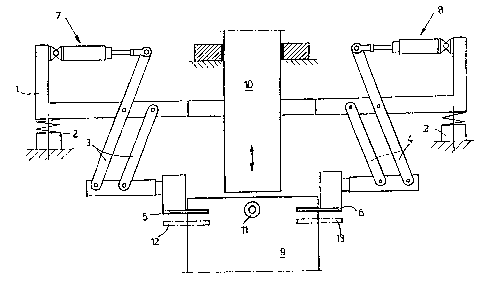Some of the information on this Web page has been provided by external sources. The Government of Canada is not responsible for the accuracy, reliability or currency of the information supplied by external sources. Users wishing to rely upon this information should consult directly with the source of the information. Content provided by external sources is not subject to official languages, privacy and accessibility requirements.
Any discrepancies in the text and image of the Claims and Abstract are due to differing posting times. Text of the Claims and Abstract are posted:
| (12) Patent Application: | (11) CA 2091471 |
|---|---|
| (54) English Title: | APPARATUS FOR FILLING SACKS HAVING ONE OPEN SIDE |
| (54) French Title: | DISPOSITIF DE REMPLISSAGE DE SACS AYANT UN COTE OUVERT |
| Status: | Deemed Abandoned and Beyond the Period of Reinstatement - Pending Response to Notice of Disregarded Communication |
| (51) International Patent Classification (IPC): |
|
|---|---|
| (72) Inventors : |
|
| (73) Owners : |
|
| (71) Applicants : | |
| (74) Agent: | AVENTUM IP LAW LLP |
| (74) Associate agent: | |
| (45) Issued: | |
| (22) Filed Date: | 1993-03-22 |
| (41) Open to Public Inspection: | 1993-09-24 |
| Examination requested: | 1999-06-21 |
| Availability of licence: | N/A |
| Dedicated to the Public: | N/A |
| (25) Language of filing: | English |
| Patent Cooperation Treaty (PCT): | No |
|---|
| (30) Application Priority Data: | |||||||||
|---|---|---|---|---|---|---|---|---|---|
|
1090-30
APPARATUS FOR FILLING SACKS HAVING ONE OPEN SIDE
ABSTRACT
Sacks which are open on one side and are
preferably provided with side folds are gripped at their
side sections in the area of their open edges by pairs of
grippers, which can be displaced towards and away from each
other. The lateral walls of the sacks are pulled apart
adjacent the open edges between the grippers by suction
elements arranged in a rack of the apparatus. In the rack
there are arranged filling necks which can be lowered and
raised into and out of the open sacks. A sealing device
closes the open edges of the sacks which are closed by
moving apart the grippers thus pulling the edges tightly
against each other. In order to be able to detect the
desired net weight of the filling quantity with a high
accuracy, the pair of grippers and the drive means for the
opening and closing movements, and for the displacement of
the grippers towards and away from each other, are arranged
on carrying means which are connected with the rack by means
of weighing devices. This separate carrying means minimizes
the amount of the apparatus which must be included in the
gross weighing thereby minimizing the relative error.
Note: Claims are shown in the official language in which they were submitted.
Note: Descriptions are shown in the official language in which they were submitted.

2024-08-01:As part of the Next Generation Patents (NGP) transition, the Canadian Patents Database (CPD) now contains a more detailed Event History, which replicates the Event Log of our new back-office solution.
Please note that "Inactive:" events refers to events no longer in use in our new back-office solution.
For a clearer understanding of the status of the application/patent presented on this page, the site Disclaimer , as well as the definitions for Patent , Event History , Maintenance Fee and Payment History should be consulted.
| Description | Date |
|---|---|
| Inactive: Adhoc Request Documented | 2018-06-06 |
| Appointment of Agent Requirements Determined Compliant | 2018-05-18 |
| Revocation of Agent Requirements Determined Compliant | 2018-05-18 |
| Inactive: IPC from MCD | 2006-03-11 |
| Application Not Reinstated by Deadline | 2003-03-24 |
| Time Limit for Reversal Expired | 2003-03-24 |
| Deemed Abandoned - Conditions for Grant Determined Not Compliant | 2002-07-09 |
| Deemed Abandoned - Failure to Respond to Maintenance Fee Notice | 2002-03-22 |
| Notice of Allowance is Issued | 2002-01-09 |
| Notice of Allowance is Issued | 2002-01-09 |
| Letter Sent | 2002-01-09 |
| Inactive: Approved for allowance (AFA) | 2001-12-27 |
| Amendment Received - Voluntary Amendment | 1999-10-21 |
| Inactive: Application prosecuted on TS as of Log entry date | 1999-07-06 |
| Letter Sent | 1999-07-06 |
| Inactive: Status info is complete as of Log entry date | 1999-07-06 |
| All Requirements for Examination Determined Compliant | 1999-06-21 |
| Request for Examination Requirements Determined Compliant | 1999-06-21 |
| Application Published (Open to Public Inspection) | 1993-09-24 |
| Abandonment Date | Reason | Reinstatement Date |
|---|---|---|
| 2002-07-09 | ||
| 2002-03-22 |
The last payment was received on
Note : If the full payment has not been received on or before the date indicated, a further fee may be required which may be one of the following
Please refer to the CIPO Patent Fees web page to see all current fee amounts.
| Fee Type | Anniversary Year | Due Date | Paid Date |
|---|---|---|---|
| MF (application, 5th anniv.) - standard | 05 | 1998-03-23 | 1998-02-17 |
| MF (application, 6th anniv.) - standard | 06 | 1999-03-22 | 1999-02-18 |
| Request for examination - standard | 1999-06-21 | ||
| MF (application, 7th anniv.) - standard | 07 | 2000-03-22 | 2000-02-23 |
| MF (application, 8th anniv.) - standard | 08 | 2001-03-22 | 2001-02-22 |
| MF (application, 2nd anniv.) - standard | 02 | 1995-03-22 |
Note: Records showing the ownership history in alphabetical order.
| Current Owners on Record |
|---|
| WINDMOLLER & HOLSCHER |
| Past Owners on Record |
|---|
| HELMUT HUWELMANN |